![]()
![]()
![]()
Use LEFT and RIGHT arrow keys to navigate between flashcards;
Use UP and DOWN arrow keys to flip the card;
H to show hint;
A reads text to speech;
7 Cards in this Set
- Front
- Back
- 3rd side (hint)
|
Angina Pectoris |
Decreased blood supply to the portion of the myocardium leading to temporary ischemia , usually due to atherosclerotic deposits in the coronary arteries |
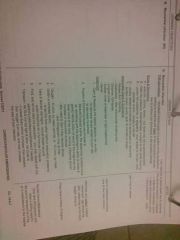
S/S P - exercise, activity, stress, eating too much Q - feels like pressure, chest tightness, a weight on the chest, burning R - usually felt substernal, or epigastric - may radiate to the jaw, neck, shoulder or arm - usually on the left S - usually ranked as mild or moderate pain or discomfort T - sudden onset, it is a little s only 3 - 5 minutes, rarely past 10 Associated signs / symptoms - dyspnea, diaphoresis, nausea or vomiting, severe apprehension, belching |
|
|
Myocardial Infarction |
Decreased blood supply to a portion of the myocardium leading to ischemia and death of the myocardium usually do to a blood clot (thrombus) in the coronary arteries |

S/S P - exercise, activities, stress - but there may be no provoking Factor Q - feels like pressure, chest tightness, a weight on the chest, burning R - usually felt substernal, or epigastric - may radiate to the jaw, neck, shoulder or arm - usually on the left S - usually ranked as moderate to severe pain or discomfort T - sudden onset, usually last 30 minutes or longer Assoc. S/S - Nausea / vomiting - diaphoresis - Dyspnea, orthopnea - Irregular pulse - Sudden onset of weakness or lightheadedness - denial |
|
|
Left Sided CHF |
-Chronic weakening of the left ventricle due to failure under excessive workload, old infarction, faulty valves - caused by chronic hypertension, excessive nicotine use, previous MI, beta blocker use - Left ventricular ejection fraction drops, but write hearts remains the same , excess blood pools in the lungs causing pulmonary edema |
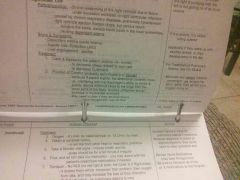
S/S - Slow onset, often over several days - but may not be noticed until acute - Dyspnea, shortness of breath, productive cough -orthopnea= difficulty breathing when lying supine - Setting up - often found propped up on pillows - may have spent the last evening that way, sleeping in chair - Pulmonary edema - from excessive pulmonary capillary pressure and increase respiratory effort= greater inspiratory vacuum |
|
|
Right Sided CHF |
-Chronic weakening of the right ventricle to to failure under excessive workload, or right ventricular infarction - Caused by chronic respiratory disease, pulmonary hypertension - Right ventricular ejection fraction drops, but Venous return remains the same, excess blood pools in the lower extremities, causing dependent edema |

S/S - Dependent edema (pedal edema) - jugular vein distinction - Liver engorgement - ascites |
|
|
Hypertensive Crises "symptomatic hypertension" |
This is hypertension with the risk that prolonged hypertension can lead to an aneurysm bursting or to heart failure from the excessive workload |
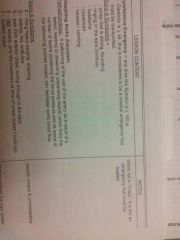
S/S Hypertension with angina, pulmonary edema, pregnancy, or signs of cerebral edema ( such as unusually severe headache, blurred vision / visual disturbances, nausea or vomiting, altered mental status, focal neurological signs of deficit, paresthesias, dizziness, vertical or tinnitus) , epistaxis, chest pain, shortness of breath, abdominal or back pain |
|
|
Hypertensive Emergancy |
any kind of systolic is more than or equal to 160 or diastolic is more than or equal to 94 , this is considered to be a medical emergency that must be transported |
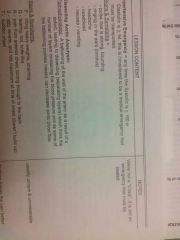
S/S - pulse that is strong, bounding - Ringing in the ears (tinnitus) - Headache - epistaxis - Nausea / vomiting |
|
|
Dissecting Aortic Aneurysm |
hey ballooning of the wall of the artery as a result of a defect, leading to a dissecting (separating layers) which tends the number of layers containing the blood pressure and as some of the ballooning pushes inward, can decrease aortic blood flow |
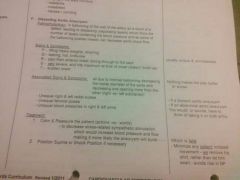
S/S P - lifting heavy weights, straining Q - tearing, hot, knife like R - pain from anterior chest, boring through the back S - very severe, and hits maximum at time of onset (doesn't build up) T - sudden onset Assoc. S/S - Unequal right and left radial pulses - Unequal femoral pulses - Unequal blood pressures in right and left arms |

